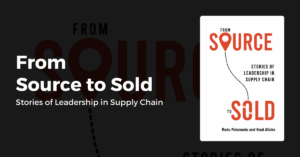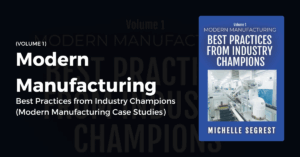The Gen AI Manufacturing Revolution - Smarter Factories, Enhanced Products, and Reduced Costs
[ Author: Matthew Alberts, PhD ]
Nov 5, 2025
No time to read the Must-Read: Listen to the one-minute summary.
In manufacturing, the gap between understanding AI and leveraging it profitably has never been wider. Most leaders have heard the pitch—now they need the playbook.
Quick Summary
The Gen AI Manufacturing Revolution – Smarter Factories, Enhanced Products, and Reduced posts by Matthew Alberts, PhD, is a strategic roadmap for integrating Generative and Agentic AI into manufacturing operations. The book explores how manufacturers—from small shops to global enterprises—can leverage AI to optimize production, enhance supply chains, reduce costs, and gain a competitive advantage. It combines frameworks, case studies, and governance principles with practical steps for adoption at every organizational scale.
About Author
Matthew Alberts holds a PhD in Industrial Engineering from the University of Tennessee, an MBA in Finance from the University of Houston, and a BS in Mechanical Engineering from Georgia Tech. With over 15 years of experience driving digital transformation across the manufacturing, energy, and industrial sectors, he has held leadership roles at Georgia-Pacific and Southern Company, focusing on AI, robotics, IoT, and predictive analytics.
Key Takeaways
Start small, scale smart
Small manufacturers should focus on one or two high-ROI areas, such as customer support automation or process optimization, by using off-the-shelf AI solutions rather than deploying them across the board.
Build on data, not hope
AI needs clean, well-organized data to function effectively. Before any pilot, ask: “Is the data structured and high quality?” Without it, even the best AI models will fail.
Combine creation with action
Generative AI designs and simulates; Agentic AI decides and executes autonomously. The two work together—Gen AI can design a new product line while Agentic AI predicts demand, optimizes schedules, and manages distribution.
Governance isn’t overhead—it’s competitive advantage
In the hyper-connected “1-degree world,” trust and transparency in AI aren’t just good practice—they’re what separates winners from liability risks.
What Small and Mid-Sized Manufacturers Need to Know
The book is particularly strong on scaling AI based on company size—a critical distinction most AI literature ignores.
For Small Manufacturers (under 100 employees, <$10M revenue):
- Focus on low-cost, high-impact AI: chatbots, email marketing automation, and bookkeeping
- Prioritize quick wins to build internal momentum and support
- Use off-the-shelf solutions rather than custom builds
- Key challenge: Limited budgets and lack of in-house expertise mean partnerships and upskilling are essential
For Mid-Sized Manufacturers (100–1,000 employees, $10M–$1B revenue):
- Deploy AI to integrate departments and expand capabilities
- Use cases include AI-driven marketing insights, sales forecasting, and logistics optimization
- Key challenge: Balancing cost with innovation while addressing the talent gap
- Long-term investments should focus on predictive analytics and supply chain AI
Real-World Impact: The Regional Manufacturer Case
A Midwest manufacturing company started with a pilot program to optimize production line efficiency. Results: 12% increase in throughput and significant reduction in equipment downtime through AI-driven predictive maintenance.
Encouraged, they scaled across the entire operation, encompassing production planning, quality control, and supply chain management. They invested in cloud-based AI platforms, upgraded data infrastructure, and launched a reskilling initiative for factory managers and operators.
The payoff: 20% reduction in operating costs, streamlined supply chains, and increased production capacity—without additional capital investment in equipment.
The “1-Degree World” and Why It Matters
Alberts introduces the concept of a 1-degree world—where the distance between people, systems, and solutions has been reduced to zero. A manufacturer who once needed weeks to source raw materials through brokers can now connect directly with suppliers, optimizing costs, availability, and delivery schedules in seconds.
This isn’t just speed—it’s precision in decision-making:
- Production optimization: Predictive AI analyzes machine performance and schedules maintenance before failures occur
- Supply chain resilience: AI monitors global logistics, anticipates disruptions (port delays, material shortages), and reroutes shipping in real time
- Quality control at scale: Computer vision detects defects at micron-level accuracy, ensuring quality and reducing rework
The Two Forms of AI Manufacturers Must Understand
Generative AI creates text, visuals, designs, and simulations. It inspires, refines, adapts. Think ChatGPT for manufacturing: it can generate product concepts, optimize part designs, or simulate demand scenarios.
Agentic AI acts—it reasons, makes decisions, and executes autonomously. Example: A supply chain AI detects a disruption, identifies alternative suppliers, and reconfigures logistics without human intervention.
Together, they compress innovation timelines. In one case cited, a manufacturer utilized Generative AI to redesign a bracket, resulting in a 26% reduction in weight and an 8% decrease in cost. Generative design algorithms have cut component weight and development time by 30–50% across multiple industries.
Practical Implementation: The 5-Step Framework
Alberts provides a structured approach for integrating AI:
- Assess business needs: Identify use cases, prioritize based on feasibility, ROI, and strategic alignment
- Conduct pilot projects: Define scope, establish KPIs, ensure cross-functional collaboration
- Build the right infrastructure: Cloud-based platforms, seamless ERP/CRM integration, robust security
- Establish AI governance: Data privacy compliance (GDPR, CCPA), bias-mitigation frameworks, audit trails
- Scale and refine: Deploy across departments, monitor performance, retrain models based on feedback
Critical insight: AI must be deployed not only where there are pressing issues but also where it will deliver quick wins to build momentum and support within the organization.
The Governance Imperative
One of the book’s strongest sections addresses AI governance—not as a bureaucratic process, but as a business necessity.
Without proper oversight, AI-driven systems can lead to biased decision-making, regulatory violations, and reputational damage. For instance, AI systems used in predictive maintenance must be routinely evaluated to ensure they’re not unintentionally prioritizing certain machines in ways that could lead to equipment failure or safety hazards.
Key governance elements:
- Data ethics and bias mitigation
- Transparency and explainability (Explainable AI/XAI)
- Clear accountability structures
- Compliance with evolving regulations (EU AI Act, ISO/IEC 42001)
As Alberts notes: “In the hyper-connected 1-degree world, trust and transparency in AI aren’t just good practice—they’re competitive advantages.”
When AI Fails: Lessons from the Trenches
The book doesn’t sugarcoat the adoption of AI. Two failure cases stand out:
Failure Case 1: An AI-driven maintenance system in a heavy equipment manufacturer failed due to poor data quality and insufficient domain expertise during model development.
Failure Case 2: An autonomous material handling system in a warehouse failed because AI agents were trained under controlled conditions that didn’t reflect real-world variability.
The lesson: Data infrastructure must be modernized before AI implementation. Real-time, high-quality data is non-negotiable for accurate AI decision-making.
The Human Element
Despite the focus on automation, Alberts is clear: humans aren’t removed from decision-making—they ensure decisions align with ethical principles and strategic goals.
Research cited from Google indicates that teams with higher psychological safety are more effective in tackling complex challenges, such as AI adoption.
When employees trust that their input is valued, they become active collaborators with AI systems rather than passive observers.
The book emphasizes cultural transformation alongside technical deployment: transparent communication, cross-functional collaboration, AI literacy programs, and recognition of AI-driven initiatives.
Measuring Success: Beyond the Hype
Chapter 11 provides specific KPIs by business function:
- Customer service: AI-driven response time (seconds)
- Operations: Process automation rate (%)
- Supply chain: Inventory prediction accuracy (%)
- Finance: Fraud detection success rate (%)
Critical concept: Model drift. Over time, AI models become less accurate as underlying data patterns change. The book provides a framework for detecting drift indicators (a drop in prediction accuracy or an increase in false positives) and implementing countermeasures (retraining with updated data or adjusting decision thresholds).
Memorable Quotes
“AI adoption is as much a cultural transformation as it is a technical shift.” — Matthew Alberts
“AI adoption should be approached as an ongoing optimization journey rather than a one-time deployment.” — Matthew Alberts
Summary
A comprehensive guide for manufacturing leaders ready to move beyond AI experimentation.
Alberts combines strategic frameworks with practical case studies, making this especially valuable for small and mid-sized manufacturers who need clear ROI justification and phased implementation plans.
The emphasis on governance, data readiness, and cultural transformation sets it apart from purely technical AI books. Worth reading if you’re serious about competitive advantage in the next decade.

About the Curator:
Tamizh Selvan Dinakaran has over 25 years of experience helping businesses grow through digital marketing, particularly in the distribution and manufacturing sectors. He currently leads customer education at DCKAP, where he creates programs designed to help customers succeed in deriving value from DCKAP’s products. Previously, as DCKAP’s Director of Marketing, he focused on increasing brand awareness and generating leads through effective content marketing. Tamizh specializes in B2B content marketing, marketing operations, and customer success.
Read More Book Reviews
ERP Integration made simple for Manufacturers & Distributors.
Transform your commerce journey by creating an integrated experience for employees and customers.




